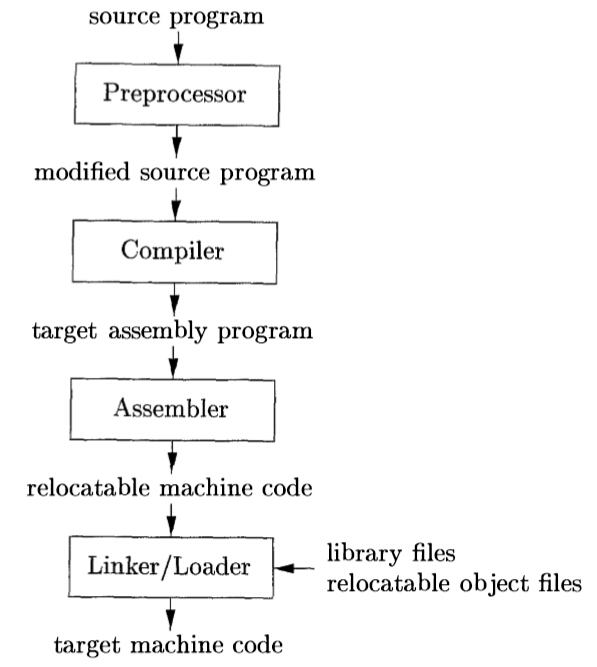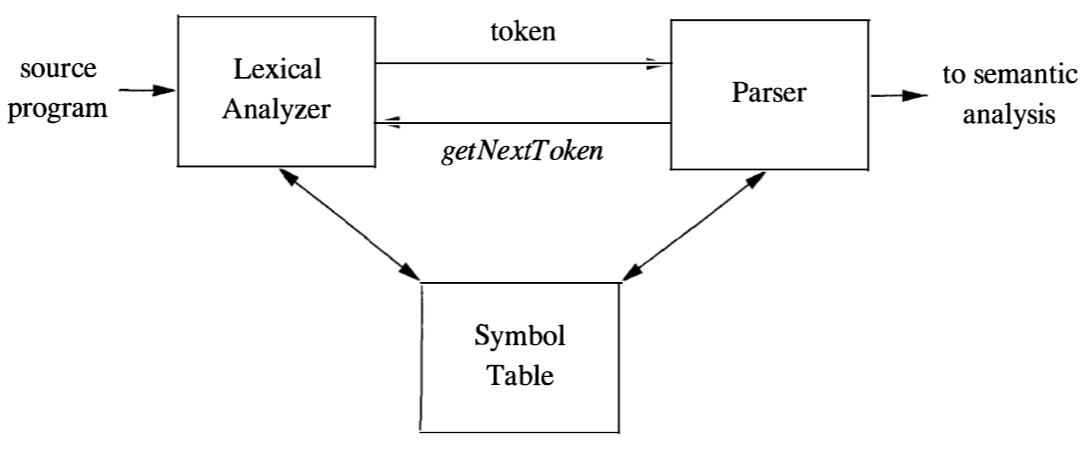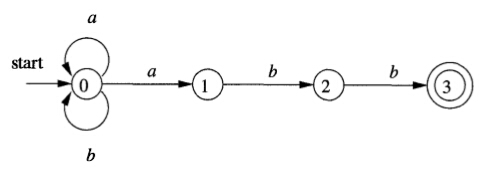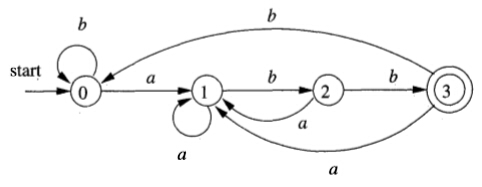拖了快半年了,终于把《硬件/软件接口》过完了,第一遍看的比较粗略,也深深地意识到深入学CPU的难度之大T_T,回来先把编译原理的坑给填了吧Q_Q。
课后答案:http://dragon-book.jcf94.com/
官方主页:http://dragonbook.stanford.edu/
看了几章,感觉《龙书》里面废话很多啊,很多东西都重复讲了好多遍,而且感觉第二章很多余。
不知道是不是我太肤浅了。
1. Introduction
引论
1.1 language processors
语言处理器
区别一下编译器(Compiler)和解释器(Interpreter):
高级语言的源程序经过编译器编译后产生目标程序,然后将数据输入目标程序得到输出结果;解释器则是同时将数据和源程序输入,利用输入的数据来执行源程序中指定的操作,得到输出。
通常,一个完整的语言处理系统(高级语言编译器)由以下几部分组成:

高级语言通过一系列步骤,最终生成能够在机器上执行的机器码。
1.2 the structure of a compiler
编译器的结构
编译器整体上可以分为两个部分:分析部分(前端)和综合(后端)。
分析是将源程序分解成多个组成要素,收集有关的信息放在一个符号表(Symbol Table)里,并产生一个中间表示形式。
综合则是根据上一步得到的符号表和中间表示形式进一步生成机器码。
常把编译的过程分成5个阶段:
- Lexical Analysis 词法分析
- Parsing 语法分析
- Semantic Analysis 语义分析
- Optimization 中间代码生成和优化
- Code Generation 代码生成
1.3 the evolution of programming languages
程序设计语言的发展历程
1.4 the science of building a compiler
构建编译器的科学
1.5 applications of compiler technology
编译技术的应用
1.6 programming language basics
程序设计语言基础
1.7 summary of chapter 1
1.8 references for chapter 1
2. A Simple Syntax-directed Translator
一个简单的语法制导翻译器
2.1 introduction
引言
2.2 syntax definition
语法定义
本节定义了一种上下文无关文法(Context-free Grammar),其由四个元素组成:
- 一个终结符号集合:文法中语言基本符号的集合
- 一个非终结符号集合:每个非终结符号表示一个终结符号串的集合
- 一个产生式集合:
箭头左边称为产生式头,右边称为产生式体。用于表示某个构造的某种书写形式。意为:产生式头 可以具有 产生式体 的形式 - 指定一个非终结符号为开始符号
有了明确的定义之后,文法推导就是:
从开始符号出发,不断将某个非终结符号替换为该非终结符号的某个产生式的体。
则可以从开始符号推导出来的所有终结符号串的集合,即称为该文法定义的语言。
语法分析(Parsing)的任务是:接受一个终结符号串作为输入,找出从文法开始符号推导出这个串的方法。
如果不能推导出来,则报告该符号串中包含语法错误。
2.3 syntax-directed translation
语法制导翻译
2.4 parsing
语法分析
2.5 a translator for simple expressions
简单表达式的翻译器
本章是以一个简单的文法制导翻译器为例,介绍编译的过程。
前几节是对中缀转后缀表达式翻译器文法、语法方面的分析。
书中在这里给出了一个极其简单的中缀转后缀的表达式翻译器:
1 | /* *********************************************** |
平时JAVA用的比较少,正好这时候多熟悉下
2.6 lexical analysis
词法分析
前一节中的翻译器功能比较弱,为了在不改变语法的情况下扩充其功能,在词法分析这一步加入更多内容。
2.7 symbol tables
符号表
词法分析的目的是按照文法从源程序中提取出各种词素,存在符号表中,然后将分析完的词素信息交给语法分析器。
在这里还有个作用域的问题,因此符号表的整体结构是一个栈的形态,每进到一个新的代码块中,就应该多建立一个符号表,查找变量定义时,则是从内层向外层逐层查询。
2.8 intermediate code generation
生成中间代码
2.9 summary of chapter 2
3. Lexical Analysis
词法分析
3.1 the role of the lexical analyzer
词法分析器的作用

3.2 input buffering
输入缓冲
3.3 specification of tokens
词法单元的规约
介绍了正则表达式的相关规则。
3.4 recognition of tokens
词法单元的识别
介绍了使用状态转换图来分析词法单元的方法。
3.5 the lexical-analyzer generator lex
词法分析器生成工具Lex
3.6 finite automata
有限自动机
有限自动机是一种识别器,它们只能对每个可能的输入串回答是或者否。
有限自动机可以分为两类:
- 不确定的有限自动机(Nondeterministic Finite Automata)
对边上的标号没有限制,同一个标号可能有多条离开一个状态的边 - 确定的有限自动机(Deterministic Finite Automata)
每个状态下对于每个独立的符号,只有一条边
正则表达式 $(a|b)^*abb$ 的NFA和DFA示例:


NFA抽象地表示了用来识别某个语言串的算法,DFA则是一个具体可以实现该语言串的算法。
3.7 from regular expressions to automata
从正则表达式到自动机
通常有了正则表达式就很容易得到它的NFA,而模拟NFA对于软件来说肯定是没有模拟DFA来的方便。因此常要将NFA转化为DFA,再交给软件去模拟。(当然,有时候从NFA到DFA的转化代价可能要大于直接模拟NFA,这时候就不会考虑再转化了)
书中介绍了一种广搜算法来完成NFA到DFA的转化。
子集构造法
1 | initially, t-closure(so) is the only state in Dstates, and it is unmarked; |
计算t-closure(T)
1 | push all states of T onto stack; |
3.8 design of a lexical-analyzer generator
词法分析器生成工具的设计
3.9 optimization of dfa-based pattern matchers
基于DFA模式匹配器的优化
3.10 summary of chapter 3
3.11 references for chapter 3
4. Syntax Analysis
语法分析
4.1 introduction
引论
4.2 context-free grammars
上下文无关文法
4.3 writing a grammar
设计文法
4.4 top-down parsing
自顶向下的语法分析
4.5 bottom-up parsing
自底向上的语法分析
4.6 introduction to lr parsing: simple lr
LR语法分析技术介绍:简单LR
4.7 more powerful lr parsers
更强大的LR语法分析器
4.8 using ambiguous grammars
使用二义性文法
4.9 parser generators
语法分析器生成工具
4.10 summary of chapter 4
4.11 references for chapter 4
5. Syntax-directed Translation
语法制导的翻译
5.1 syntax-directed definitions
语法制导定义
5.2 evaluation orders for sdd’s
SDD的求值顺序
5.3 applications of syntax-directed translation
语法制导翻译的应用
5.4 syntax-directed translation schemes
语法制导的翻译方案
5.5 hnplementing l-attributed sdd’s
实现L属性的SDD
5.6 summary of chapter 5
5.7 references for chapter 5
6. Intermediate-code Generation
中间代码生成
6.1 variants of syntax trees
语法树的变体
6.2 three-address code
三地址代码
6.3 types and declarations
类型和声明
6.4 translation of expressions
表达式的翻译
6.5 type checking
类型检查
6.6 control flow
控制流
6.7 backpatching
回填
6.8 switch-statements
switch语句
6.9 intermediate code for procedures
过程的中间代码
6.10 summary of chapter 6
6.11 references for chapter 6
7. Run-time Environments
运行时环境
7.1 storage organization
存储组织
7.2 stack allocation of space
空间的栈式分配
7.3 access to nonlocal data on the stack
栈中非局部数据的访问
7.4 heap management
堆管理
7.5 introduction to garbage collection
垃圾回收概述
7.6 introduction to trace-based collection
基于跟踪的回收概述
7.7 short-pause garbage collection
短停顿垃圾回收
7.8 advanced topics in garbage collection
垃圾回收中的高级论题
7.9 summary of chapter 7
7.10 references for chapter 7
8. Code Generation
代码生成
8.1 issues m the design of a code generator
代码生成器设计中的问题
8.2 the target language
目标语言
8.3 addresses in the target code
目标代码中的地址
8.4 basic blocks and flow graphs
基本块和流图
8.5 optimization of basic blocks
基本块的优化
8.6 a simple code generator
一个简单的代码生成器
8.7 peephole optimization
窥孔优化
8.8 register allocation and assignment
寄存器分配和指派
8.9 instruction selection by tree rewriting
通过树重写来选择指令
8.10 optimal code generation for expressions
表达式的优化代码的生成
8.11 dynamic programming code-generation
动态规划代码生成
8.12 summary of chapter 8
8.13 references for chapter 8
9. Machine-independent Optimizations
机器无关优化
9.1 the principal sources of optimization
优化的主要来源
9.2 introduction to data-flow analysis
数据流分析简介
9.3 foundations of data-flow analysis
数据流分析基础
9.4 constant propagation
常量传播
9.5 partial-redundancy elimination
部分冗余的消除
9.6 loops in flow graphs
流图中的循环
9.7 region-based analysis
基于区域的分析
9.8 symbolic analysis
符号分析
9.9 summary of chapter 9
9.10 references for chapter 9
10. Instruction-level Parallelism
指令级并行
10.1 processor architectures
处理器体系结构
10.2 code-scheduling constraints
代码调度约束
10.3 basic-block scheduling
基本块调度
10.4 global code scheduling
全局代码调度
10.5 software pipelining
软件流水线化
10.6 summary of chapter 10
10.7 references for chapter 10
11. Optimizing for Parallelism and Locality
并行性和局部性优化
11.1 basic concepts
基本概念
11.2 matrix multiply: an in-depth example
矩阵乘法:一个深入的例子
11.3 iteration spaces
迭代空间
11.4 aftlne array indexes
仿射的数组下标
11.5 data reuse
数据复用
11.6 array data-dependence analysis
数组数据依赖关系分析
11.7 finding synchronization-free parallelism
寻找无同步的并行性
11.8 synchronization between parallel loops
并行循环之间的同步
11.9 pipelining
流水线
11.10 locality optimizations
局部性优化
11.11 other uses of affine transforms
仿射转换的其他用途
11.12 summarv of chapter 11
11.13 references for chapter 11
12. Interprocedural Analysis
过程间分析
12.1 basic concepts
基本概念
12.2 why interprocedural analysis?
为什么需要过程间分析
12.3 a logical representation of data flow
数据流的一种逻辑表示方式
12.4 a simple pointer-analysis algorithm
一个简单的指针分析算法
12.5 context-insensitive interprocedural analysis
上下文无关的过程间分析
12.6 context-sensitive pointer analysis
上下文相关指针分析
12.7 datalog implementation by bdd’s
使用BDD的Datalog实现
12.8 summary of chapter 12
12.9 references for chapter 12
a. A Complete Front End
一个完整的编译器前端
a.1 the source language
源语言
a.2 main
Main
a.3 lexical analyzer
词法分析器
a.4 symbol tables and types
符号表和类型
a.5 intermediate code for expressions
表达式的中间代码
a.6 jumping code for boolean expressions
布尔表达式的跳转代码
a.7 intermediate code for statements
语句的中间代码
a.8 parser
语法分析器
a.9 creating the front end
创建前端
b. Finding Linearly Independent Solutions
Index
寻找线性独立解
待续…